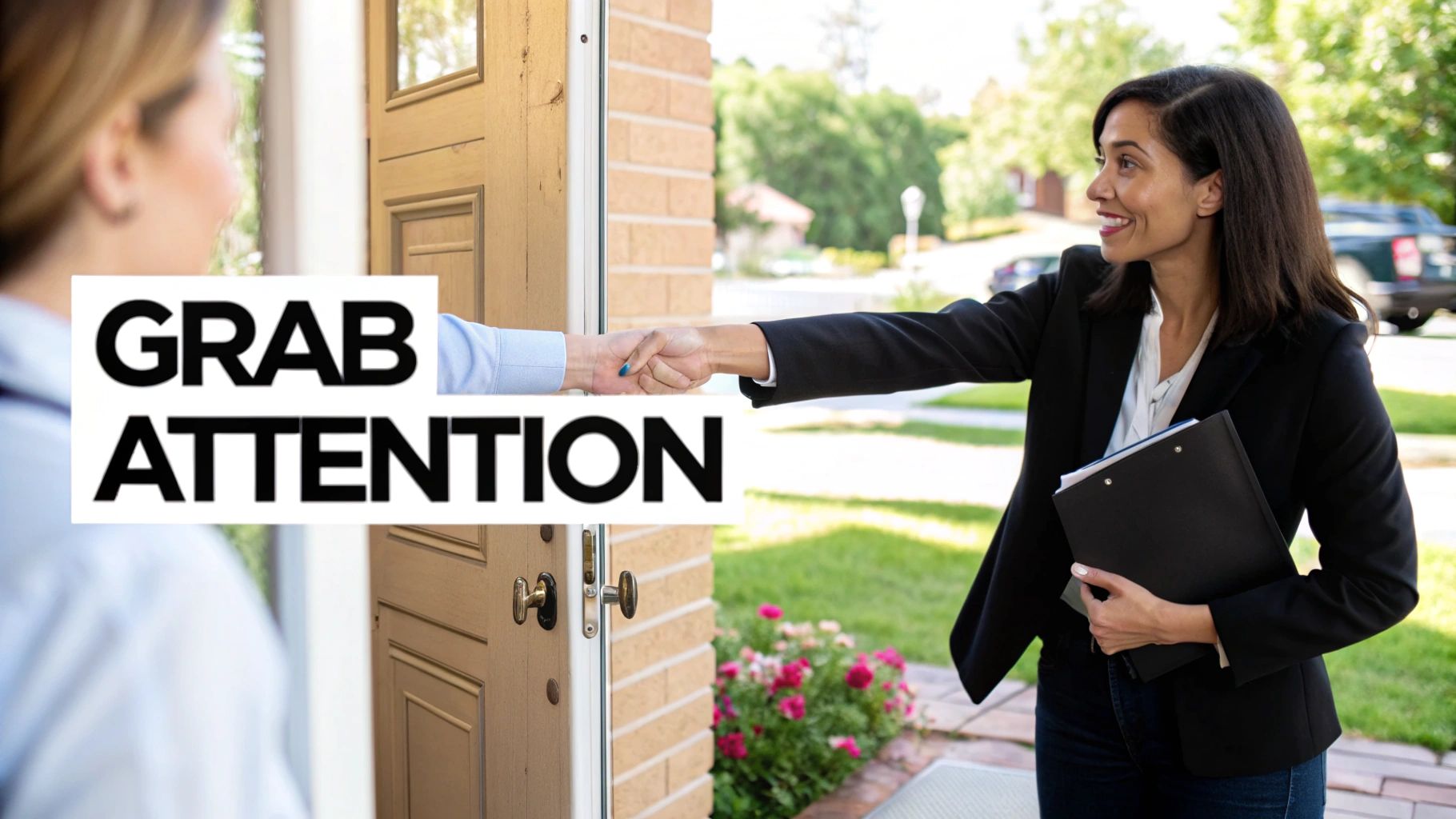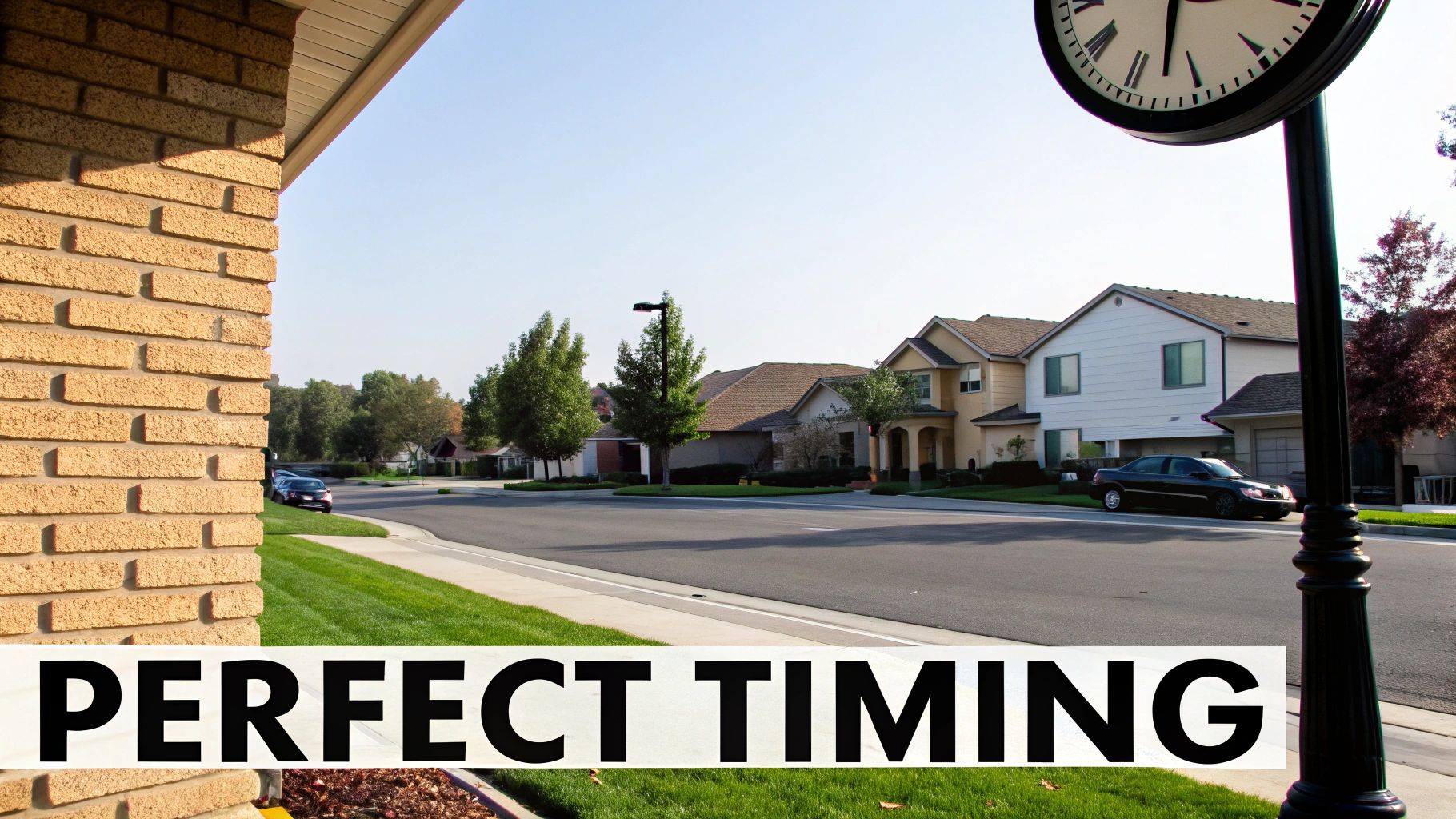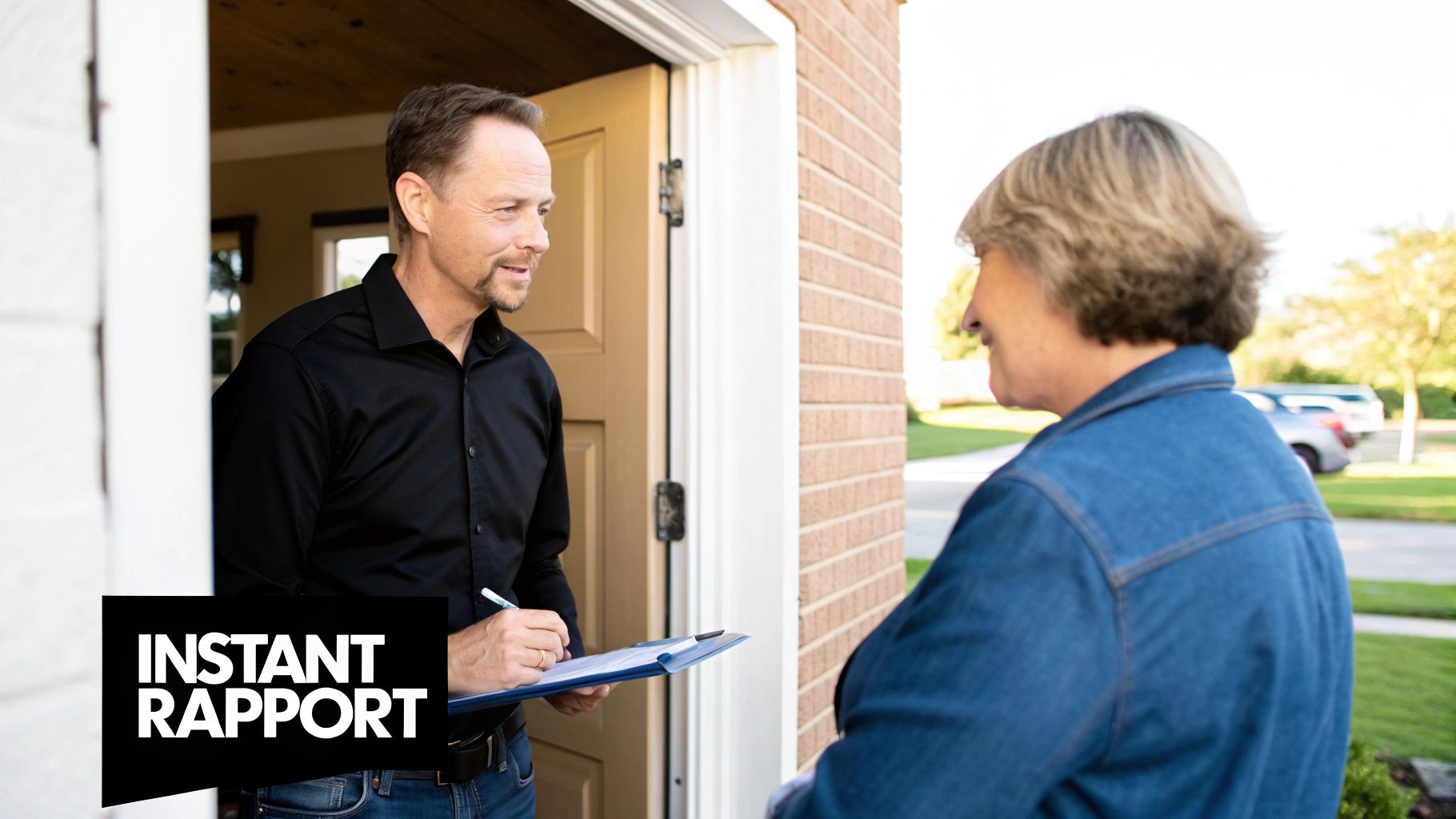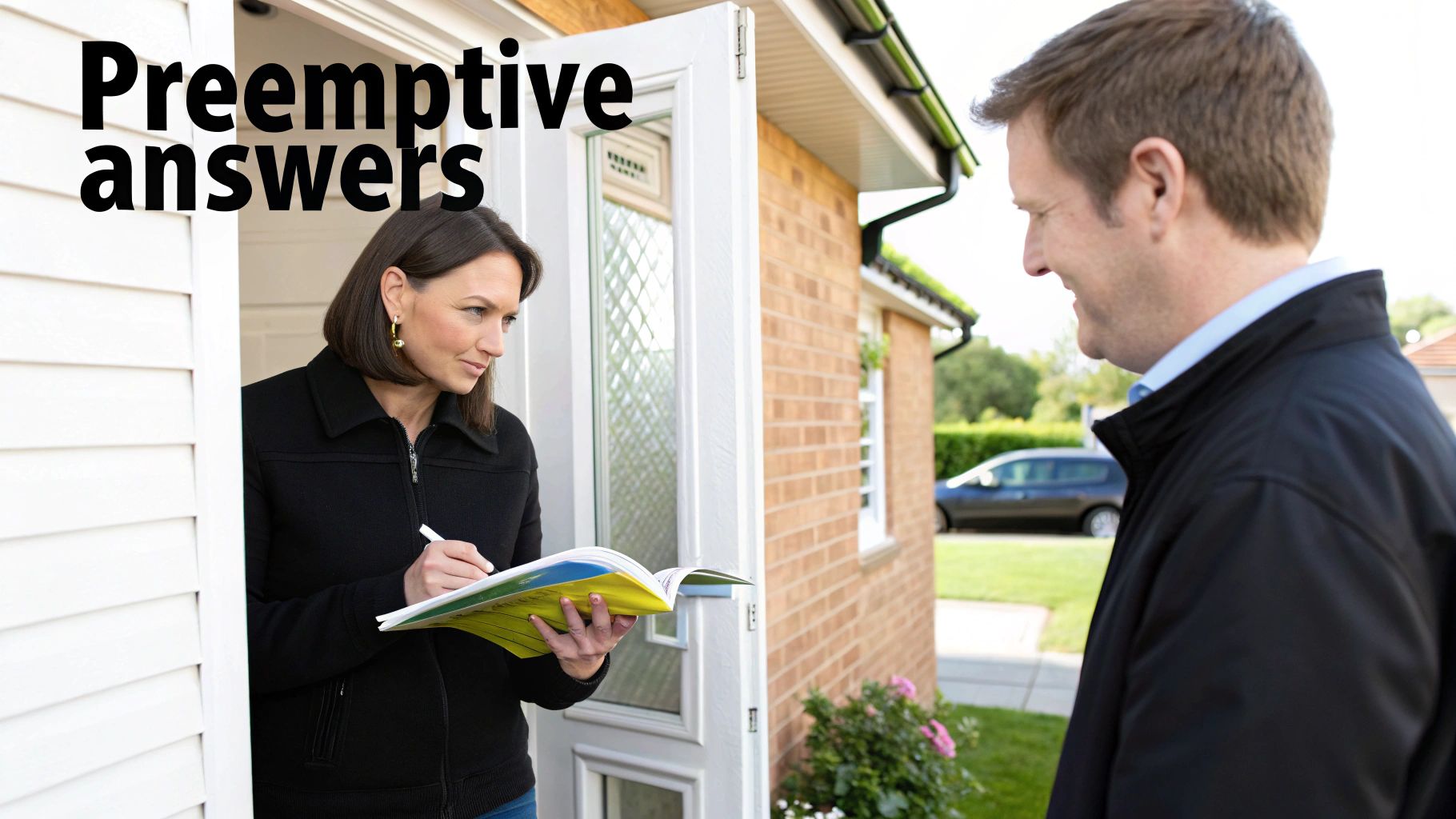Door-to-door sales remains one of the most challenging, yet rewarding, forms of selling. In a world saturated with digital noise, a face-to-face interaction can be incredibly powerful, if executed correctly. But let's be honest: the line between a welcome conversation and a slammed door is razor-thin. It all comes down to strategy, psychology, and refined technique.
Generic advice won't cut it. To succeed, field teams need specific, actionable door to door sales tips that address the nuances of modern consumer behaviour. This guide goes beyond the basics. We've compiled six battle-tested strategies for home service companies, energy consultants, and other field sales teams, breaking down the what, why, and how of each.
From perfecting your first 15 seconds to mastering the assumptive close, these insights are designed for immediate implementation. Whether you're a small business or a rapidly scaling organisation, these tips will equip you and your team to handle objections, build rapport, and turn more knocks into profitable relationships. Get ready to transform your approach and see your conversion rates soar.
1. Perfect Your Opening Hook (First 15 Seconds)
The first 15 seconds at the door are the most critical moments of any sales interaction. This is your one and only window to capture a prospect's attention, establish relevance, and prevent the door from closing. Sales experts like Grant Cardone and Jordan Belfort emphasize that prospects make an immediate subconscious decision about whether you are worth their time. A powerful opening hook bypasses their natural sales resistance and sparks curiosity, compelling them to listen further.

The goal is not to launch into a full sales pitch, but to create a "pattern interrupt" that makes you stand out from every other salesperson. Instead of a generic "Hi, my name is..." approach, a strong hook is unexpected, benefit-focused, and leverages local context to feel personal and urgent.
How to Craft a Winning Hook
A successful opening is built on relevance. Why are you at their door, right now? Mentioning neighbours, a specific issue in the area, or a visual cue you observed on their property immediately answers this question and builds a bridge of commonality.
Here are some industry-specific examples:
- Pest Control: "Hi, I'm working with a few of your neighbours on Elm Street, including the Jacksons at number 42. They're dealing with an ant problem that seems to be affecting this whole block, and I wanted to quickly show you what we're doing to solve it."
- Solar Sales: "Hi there. I was just leaving your neighbour's place and noticed your hydro meter is really spinning. A lot of folks in this area are locking in lower fixed rates to cut their bills by up to 70% before the next rate hike, and I'm just letting everyone know how."
- Home Security: "Good afternoon. Your neighbour Mrs. Johnson asked me to stop by. There’s been some package theft on this street recently, and she was concerned. I'm just making sure everyone on the block is aware of the simple deterrents people are using."
Actionable Tips for Implementation
Perfecting your hook is a core skill for any successful door to door sales strategy. It requires practice and adaptability.
- Practise, Don't Memorise: Rehearse your hooks until they sound natural and conversational, not like a memorised script. Record yourself to identify and eliminate any awkward phrasing.
- Leverage Hyper-Local Cues: Use the names of streets, neighbours (with their permission), or recent local news to create instant relevance.
- Master the Pause: After delivering your hook, pause for a moment. This non-verbal cue transfers pressure to the homeowner and allows their curiosity to build, often prompting them to ask a question.
- Develop Multiple Hooks: Prepare 2-3 different opening lines. One might be neighbour-focused, another might reference a visual cue (like a weathered roof or overgrown lawn), and a third could address a recent community-wide issue. This allows you to adapt your approach based on the specific house or neighbourhood.
2. Master the Art of Proper Timing
In door-to-door sales, when you knock is just as important as what you say. Proper timing goes beyond just the hour of the day; it involves strategically aligning your presence with the prospect's mindset, schedule, and immediate needs. Sales thought leaders like Jeb Blount and Brian Tracy have long emphasised that reaching a prospect at the right moment dramatically lowers resistance and increases receptivity. The best door to door sales tips always highlight timing as a foundational pillar for success, as it dictates your access to decision-makers and the relevance of your offer.

Mastering timing means understanding the rhythm of a neighbourhood and the daily patterns of your target demographic. Knocking during dinner time will likely earn you a quick dismissal, while arriving when the homeowner is relaxed and available can lead to a productive conversation. This strategic approach ensures you’re not just knocking on doors, but knocking on doors at the precise moment your solution is most likely to be welcomed.
How to Leverage Strategic Timing
The optimal time to knock varies significantly based on what you are selling and who you are selling to. A one-size-fits-all schedule is inefficient. Instead, tailor your canvassing hours to match the context of your product and the lifestyle of your ideal customer.
Here are some industry-specific examples:
- Residential Solar: The best times are often between 10 AM and 2 PM. This window increases the chances of finding a work-from-home decision-maker or a retiree, and the midday sun makes the value proposition of solar power immediately visible and relevant.
- Home Security: Prime hours are typically in the evening, from 5 PM to 7 PM. As families return home and darkness falls, concerns about security and safety are naturally heightened, making them more receptive to your solution.
- Roofing Services: Avoid rainy days when homeowners are less likely to step outside. Focus on sunny afternoons, especially after a recent storm, when potential roof damage is most visible and top-of-mind for the property owner.
Actionable Tips for Implementation
Consistently getting your timing right requires observation, data analysis, and adaptability. These tips will help you optimise your schedule for maximum impact.
- Track Your Success Rates: Use a simple log or a dedicated door to door sales app to record the time of day for every successful interaction. Analyse this data weekly to identify your personal "golden hours" and adjust your schedule accordingly.
- Research Demographic Patterns: Understand the typical daily routines of your target market. Are you selling to young families, working professionals, or retirees? Each group has a different schedule that dictates when they are most likely to be home and willing to talk.
- Avoid Key "No-Go" Times: As a general rule, avoid knocking between 12 PM - 1 PM and 5:30 PM - 6:30 PM, as these are common meal times. Also, respect boundaries by not knocking too early in the morning (before 9 AM) or too late in the evening (after 8 PM).
- Plan Routes for Peak Hours: Organise your territory map to ensure you are in your most promising neighbourhoods during their respective peak engagement hours. Save less promising areas for off-peak times.
3. Build Immediate Rapport Through Mirroring and Matching
Rapport building is the psychological foundation that transforms a cold interaction with a stranger into a warm conversation with a potential customer. Mirroring and matching involves subtly aligning your body language, speech patterns, and energy level with your prospect's to create subconscious comfort and trust. This powerful technique, popularised by figures like Tony Robbins and former FBI agent Joe Navarro, is based on the principle that people naturally like, trust, and are persuaded by those they perceive as being similar to themselves.

When done correctly, mirroring is invisible to the conscious mind but deeply felt on a subconscious level. It's not about mimicry; it's about creating a sense of harmony and showing the prospect, non-verbally, that you are on the same wavelength. This is a crucial skill for any list of door to door sales tips because it lowers defensive barriers and makes the homeowner more receptive to your message.
How to Effectively Mirror and Match
The key is subtlety and observation. Pay close attention to the homeowner's communication style from the moment they open the door. Are they speaking quickly and with high energy, or are they slow, deliberate, and reserved? Your ability to adapt your own style to match theirs is where the magic happens.
Here are some practical examples:
- Pacing and Tone: If the prospect speaks slowly and quietly, you should lower your volume and slow down your rate of speech. Rushing them with a fast-paced pitch will create dissonance and make them feel uncomfortable.
- Posture and Gestures: If the homeowner leans against their door frame, you can subtly adopt a similar relaxed posture. If they cross their arms (a common defensive stance), you can briefly cross your own while holding your clipboard to make it seem natural, signalling that you understand their position.
- Language and Terminology: Listen to the words they use. If a homeowner uses a technical term like "BTU output" when discussing their furnace, incorporating that same term shows you're listening and are knowledgeable. If they use simple, direct language, avoid industry jargon.
- Energy Level: Match their overall energy. If you encounter an enthusiastic, upbeat person, bring your own energy up to meet theirs. Conversely, with a more reserved or serious individual, a calm, measured approach will be far more effective than over-the-top excitement.
Actionable Tips for Implementation
Mastering mirroring and matching requires conscious practice until it becomes an automatic part of your sales process. It’s a nuanced skill that separates average reps from top performers.
- Start Small: Begin by matching just one element at a time. Focus first on their pace of speech, as it's often the easiest and most impactful. Once that feels natural, you can begin incorporating posture or gestures.
- Be a Chameleon, Not a Parrot: The goal is to reflect, not to copy. If they scratch their nose, don't immediately scratch yours. Instead, wait a few moments and then touch your chin. The delay and slight variation make it feel natural rather than staged.
- Practise Active Listening: You cannot effectively match someone's communication style if you are not genuinely listening. Pay attention not just to what they say, but how they say it. This is fundamental to all great door to door sales tips.
- Use Their Name: Pay attention to how they introduce themselves. If they say, "I'm Mr. Davidson," refer to them as such. If they say, "Call me Bill," using their first name builds a friendlier rapport.
4. Handle Objections Before They Arise
The most effective salespeople don’t just react to objections; they anticipate and neutralize them before the prospect even has a chance to voice them. This proactive approach, known as preemptive objection handling, demonstrates experience, builds immense credibility, and prevents common concerns from derailing your sales process. By addressing potential resistance points upfront, you control the conversation, disarm skepticism, and position yourself as a trusted advisor.

This strategy, championed by sales legends like Zig Ziglar and Brian Tracy, is a cornerstone of advanced door to door sales tips. Instead of waiting for the inevitable "I can't afford it" or "I need to think about it," you weave the answers directly into your presentation. This shows the prospect you understand their mindset and have already considered their concerns, which significantly lowers their guard.
How to Address Concerns Proactively
Integrating preemptive strikes into your pitch requires knowing your audience and the most frequent pushback you receive. The key is to frame the objection as a common and understandable thought before providing a compelling resolution. This makes the prospect feel heard and validated.
Here are some industry-specific examples:
- Solar Sales: "Now, I know exactly what you're thinking, 'This all sounds great, but it probably costs a fortune upfront.' Most of your neighbours felt the exact same way until they saw how the new federal tax credits can actually make this a cash-positive investment from day one. Let me quickly show you the numbers."
- Pest Control: "A big concern for families I speak with is the safety of the products we use, especially with kids and pets around. That's exactly why our company has invested heavily in an eco-friendly, Health Canada-approved treatment that is actually safer than most household cleaners you'd buy at the store."
- Home Security: "You're probably wondering if this is just another monthly bill you don't need, and I completely get that. What most people are surprised to learn is how our system qualifies them for a significant discount on their home insurance, often saving them more than the monitoring fee itself."
Actionable Tips for Implementation
Mastering this skill turns objections from roadblocks into opportunities to build more value. It is a fundamental tactic for any professional executing a door to door sales strategy.
- Create an Objection "Hit List": Identify the top 5-10 objections you hear daily (cost, time, spouse, etc.). Write down a concise, preemptive response for each one and integrate it naturally into your script.
- Use "Feel, Felt, Found": Acknowledge their potential feeling. "I understand you might feel it's a big decision. Many of your neighbours felt the same way. What they found was..." This classic technique builds empathy before you present the solution.
- Leverage Storytelling: Instead of just stating facts, use a brief story about a neighbour who had the same concern. Stories are more persuasive and memorable than logical arguments alone.
- Ask for Confirmation: After preemptively handling an objection, confirm you've resolved it. A simple, "Does that make sense?" or "That clears things up, right?" gets a small 'yes' and keeps the momentum positive.
5. Use Social Proof and Neighbor References Strategically
Social proof is the powerful psychological tendency for people to mirror the actions of others, especially those they perceive as peers. In door-to-door sales, this principle is hyper-effective. Mentioning that you're already working with neighbours transforms you from a random stranger into a trusted community partner. As persuasion expert Robert Cialdini outlines in Influence, this technique significantly lowers a prospect's natural defence mechanisms because it provides a mental shortcut: if my neighbours trust you, maybe I should too.
This strategy is about more than just name-dropping; it’s about demonstrating tangible value and acceptance within the prospect’s immediate environment. By referencing a nearby customer, you immediately answer the unspoken question, "Why should I listen to you?" and build a foundation of credibility that a generic sales pitch could never achieve. This makes it one of the most essential door to door sales tips for any field team.
How to Leverage Community Trust
The key to using social proof is specificity and permission. Vague claims like "we're working in the area" are weak. Concrete examples backed by names (with consent), addresses, and even photos of local work provide undeniable proof of your value and presence.
Here are some industry-specific examples:
- Solar Sales: "Hi there, I'm with ABC Solar. I just finished setting up a consultation with the Martins over at 145 Maple Drive, and they mentioned you might also be curious about how to lock in a lower hydro rate. They were shocked to see they could cut their bill by nearly 60%."
- Landscaping/Lawn Care: "Good morning. I’m just leaving the Wilsons' home-they’re the ones with the new garden beds. They were thrilled with the work and suggested I show you how we’re helping neighbours improve their curb appeal before the long weekend."
- Telecommunications: "Hi, I'm working with about a dozen of your neighbours, including the family at number 28, to get them access to the new fibre optic network. It's significantly faster than what most people have on this street, and I can quickly check your home's eligibility."
Actionable Tips for Implementation
Integrating social proof requires a systematic approach to gathering and deploying information ethically and effectively.
- Always Get Permission: Before you ever mention a customer's name, address, or results, ask for their explicit permission. A simple, "Would you mind if I let your neighbours know about the great results you're getting?" is often all it takes.
- Build a Local Portfolio: Take high-quality photos or videos of your completed work in the area (with customer consent). Showing a visual of a neighbour's finished project on a tablet is incredibly persuasive.
- Implement a Referral Program: Offer a tangible reward for both the referrer and the new customer. For example, "Mrs. Smith will get a $100 credit for sending me your way, and you'll get the same bonus off your first service."
- Use Neighbourhood Maps: A visual aid like a map of the neighbourhood with pins showing current customers provides a powerful, at-a-glance demonstration of your local dominance and trustworthiness. Tracking these interactions and customer locations is vital for success, which is where optimizing your team’s assignments becomes critical. You can learn more about effective lead routing best practices to maximize this strategy.
6. Master the Assumptive Close Technique
The assumptive close is a powerful psychological tool that, when used correctly, can dramatically increase your closing rate. Instead of asking a prospect if they want to buy, you proceed with the conversation as if they have already made the decision to move forward. This technique, championed by sales leaders like Tom Hopkins and Jordan Belfort, works by confidently guiding the prospect past the stressful "yes or no" decision point and directly into the easier, lower-stakes logistical details.
This method bypasses buyer's remorse before it can even start. By moving straight to implementation, you project confidence in your solution and create a sense of momentum that makes it feel natural for the prospect to agree. It shifts the conversation from "Should I do this?" to "How will we do this?", a much simpler question for a homeowner to answer.
How to Use the Assumptive Close
The key to the assumptive close is timing. It should only be used after you have built rapport, established a clear need, and received strong buying signals like positive questions, nodding, and statements of agreement. It is not an aggressive tactic, but rather the logical next step in a successful consultation.
Here are some industry-specific examples:
- Roofing: "Based on what we've discussed, this is definitely the best solution for you. I'll just need to get up on the roof for a final measurement. Do you happen to have a ladder I can use, or should I grab mine from the truck?"
- Solar Sales: "Great, this all makes sense. To lock in your rate before the next price increase, we'll need to get your file submitted. I've got my calendar here; we have installation slots open next Tuesday or Thursday morning. Which of those works better for you?"
- Home Security: "Perfect. So, the next step is to just map out the entry points. It'll only take about five minutes. Is now a good time for me to quickly walk the perimeter with you?"
Actionable Tips for Implementation
Using this technique effectively requires confidence and situational awareness. It is a finesse move, not a high-pressure tactic.
- Watch for Buying Signals: Only deploy the assumptive close after the prospect has shown clear interest. Look for verbal cues ("That sounds great," "How soon could you start?") and positive body language.
- Maintain a Confident Tone: Deliver your closing statement in a calm, matter-of-fact tone. Your confidence is contagious and reassures the prospect they are making the right choice.
- Be Prepared to Pivot: If you sense hesitation or resistance, immediately slow down. Revert to asking questions to uncover their concern. Forcing the close will break trust instantly.
- Have Logistics Ready: Be ready to act. Have your calendar, measuring tools, or agreement forms in hand. This reinforces that moving forward is the natural next step. To learn more about how top teams manage this process, check out our guide on getting started with lead flow management.
